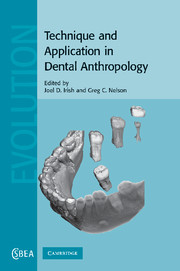Book contents
- Frontmatter
- Contents
- Contributors
- Acknowledgments
- Section I Context
- 1 Introduction
- 2 History of dental anthropology
- 3 Statistical applications in dental anthropology
- Section II Applications in assessing population health
- Section III Applied life and population history
- Section IV Forefront of technique
- Index
- References
3 - Statistical applications in dental anthropology
Published online by Cambridge University Press: 12 September 2009
- Frontmatter
- Contents
- Contributors
- Acknowledgments
- Section I Context
- 1 Introduction
- 2 History of dental anthropology
- 3 Statistical applications in dental anthropology
- Section II Applications in assessing population health
- Section III Applied life and population history
- Section IV Forefront of technique
- Index
- References
Summary
Introduction
Statistical methods have become a mainstay in physical anthropology – and a working knowledge of statistics is as necessary in dental anthropology as in any other aspect of the field. It may seem odd to have a chapter on statistics in a book discussing advances in dental anthropology. Statistics are tools – they are means of investigating questions – not ends in themselves, and they should not drive or limit the research. Also, there are no “dental” statistics; we are dealing with the same descriptive and inferential methods used in other areas of physical anthropology and in biology generally. On the other hand, access to and familiarity with statistical methods are two essentially separate issues that have molded, and continue to influence, the development of dental anthropology, as demonstrated elsewhere in this volume.
This is not the first effort at characterizing the use of statistics in dental anthropology, and I will mention just a few key precedents. Going back a good ways, Wilder (1920) provided a rudimentary introduction to descriptive statistics in his manual on anthropometry; however, this was readily surpassed by Rudolf Martin's (1928) classic three-volume work “Lehrbuch der Anthropology,” that has a 49-page chapter on statistical methods. Martin's review was meant for all physical anthropology, with no specific mention of teeth in this chapter. The mean and measures of dispersion were described, along with the two-sample (group comparison) t-test, and Karl Pearson's correlation coefficient.
- Type
- Chapter
- Information
- Technique and Application in Dental Anthropology , pp. 35 - 68Publisher: Cambridge University PressPrint publication year: 2008
References
- 8
- Cited by



